India inducts INS Arihant into service, completes its nuclear triad
Mangalore Today News Network
New Delhi, Oct 18, 2016: Indigenous nuclear submarine INS Arihant was commissioned into service in August, a report said on Tuesday.

By inducting the 6,000-tonne submarine into service, India has quietly completed its nuclear triad, reported The Hindu on Tuesday.
The daily quoted defence sources as saying that INS Arihant was formally commissioned by Navy Chief Admiral Sunil Lanba in August.
Sources added that in a bid to maintain secrecy, it is not being referred to as INS Arihant.
After being inducted, the submarine completes India’s nuclear triad, giving it the capability to respond to nuclear strikes from sea, land and air-based systems.
INS Arihant gives second-strike capability to India, which has a clearly declared policy of "no first-use" of nuclear weapons.
INS Arihant is India’s first indigenous nuclear submarine, and the lead ship of Arihant class of nuclear-powered ballistic missile submarines launched in 2009.
It was initially expected to go for sea trials by 2012, though this happened only in December 2014.
The vessel’s miniaturised nuclear reactor, built with Russian help, went critical in 2013.
The project was undertaken by the Advanced Technology Vessel programme under the supervision of the Prime Minister’s Office and involved agencies and establishments such as the Defence Research and Development Organisation, the Department of Atomic Energy and the Submarine Design Group of the Directorate of Naval Design, besides private companies such as Larsen & Toubro.
The submarine’s design is based on the Russian Akula-1 class submarines and its 83 MW pressurised water reactor has been built with significant Russian assistance.
While its 100-member crew has been trained by Russian specialists, Indian scientists at the Bhabha Atomic Research Centre have received significant expertise in reducing the reactor size to help it fit into the 10-metre diameter hull of the submarine.
Nuclear submarines have the capability to stay out at sea longer, and don’t need to surface for a long duration.
Conventional diesel-electric submarines have to come up to the surface at regular intervals for charging their batteries.
- Mangaluru Hosts Karnataka State Police Run-2025
- Protest Against Wakf Amendment Bill Held in Mangaluru
- Missing Student Ran Away Over Exam Fear: Superintendent of Police
- Kasaragod: Missing Schoolgirl and Driver Found Dead in Merkala Forest After 26 Days
- The Intriguing Story Behind Diganth’s Mysterious Disappearance!
- Tamil Nadu CM M.K. Stalin’s Wife Visits Kollur Mookambika Temple
- Mangaluru Couple Completes Mumbai-to-Mangaluru Marathon, Eyes Guinness Record
- Eminent Aloysian Alumni Award 2025 Honors Five Achievers
- Udupi: Women Have Proved Their Strength in Every Field, Says Sri Sugunendra Thirtha Swami
- Missing II PUC Student Diganth found in Udupi after 10-day search
- Daylight burglary: Gold ornaments stolen from house in Vittal
- Illegal cattle transport: Three arrested after car crash near Gangolli
- District BJP stages protest; alleges injustice to DK in state budget
- Devotees Flock to Prayagraj’s Sangam Even After Maha Kumbh Ends
- India Condemns Vandalism at Hindu Temple in California, Calls for Strict Action
- Delhi CM Rekha Gupta-led cabinet approves ₹2,500 monthly aid for women
- After Ranya Rao’s arrest, CBI to probe international gold smuggling ring
- In a first, all-women crew runs Vande Bharat on International Women’s Day
- Elderly woman falls after wheelchair delay, Air India flags late arrival
- Jinnah must be happy with Siddaramaiah’s budget, says CT Ravi
- Chess star to Space scientist: Women achievers take over PM Modi’s X handle
- Two women, including Israeli tourist, raped near Hampi
- Over 140 killed in clashes between Syrian forces and Assad loyalists
- Actor Ranya Rao admits to role in gold smuggling; DRI gets 3-day custody
- Relief for Siddaramaiah’s wife in MUDA case, probe agency summons cancelled
- Court remands Maoist Lakshmi to six-day police custody
- Sandhya Shenoy honored with Society for Materials Chemistry Medal-2024
- White Cornus Apartment in Mangaluru
- City girl wins first place in state-level spell bee competition
- Alleged ‘Love Jihad’ Case in Mangaluru: Woman left home voluntarily, says police
- Girl fatally struck by reckless two-wheeler near Belman
- New residential complex for the judges inaugurated in Mangaluru
- Absconding accused nabbed after 8 years
- Truck with cylinders turns turtle in Beltangady
- Bhoota Kola artist dies of cardiac arrest
- Development of the country should be our goal: Ganesh Karnik
- Container truck gets stuck under Modankap railway bridge
- Truck crushes bike’s pillion rider near BC Road
- Head constable dies of heart attack
- Udupi: PDO dismissed over financial irregularities
- CITY INFORMATION
- TRAVEL
- TOURIST INFORMATION
- HEALTH CARE
- MISCELLANEOUS




 Write Comment
Write Comment E-Mail To a Friend
E-Mail To a Friend Facebook
Facebook Twitter
Twitter  Print
Print 



